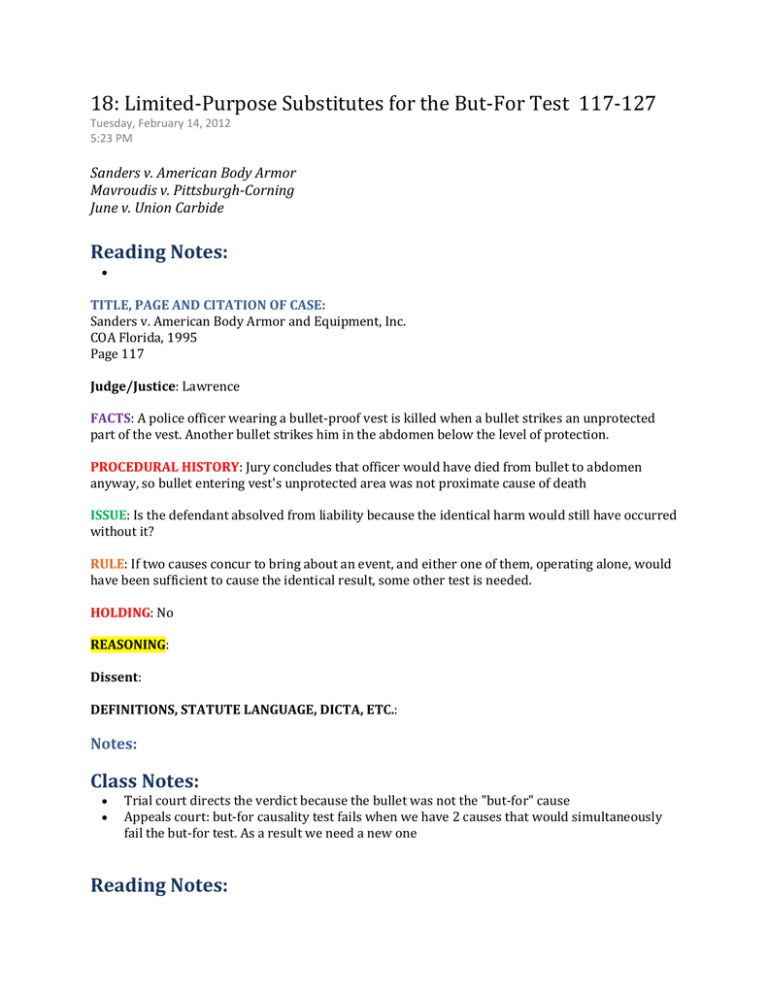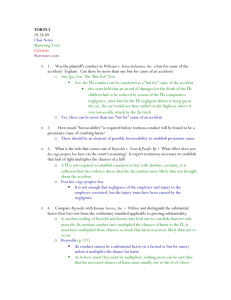in Word
advertisement

18: Limited-Purpose Substitutes for the But-For Test 117-127 Tuesday, February 14, 2012 5:23 PM Sanders v. American Body Armor Mavroudis v. Pittsburgh-Corning June v. Union Carbide Reading Notes: TITLE, PAGE AND CITATION OF CASE: Sanders v. American Body Armor and Equipment, Inc. COA Florida, 1995 Page 117 Judge/Justice: Lawrence FACTS: A police officer wearing a bullet-proof vest is killed when a bullet strikes an unprotected part of the vest. Another bullet strikes him in the abdomen below the level of protection. PROCEDURAL HISTORY: Jury concludes that officer would have died from bullet to abdomen anyway, so bullet entering vest's unprotected area was not proximate cause of death ISSUE: Is the defendant absolved from liability because the identical harm would still have occurred without it? RULE: If two causes concur to bring about an event, and either one of them, operating alone, would have been sufficient to cause the identical result, some other test is needed. HOLDING: No REASONING: Dissent: DEFINITIONS, STATUTE LANGUAGE, DICTA, ETC.: Notes: Class Notes: Trial court directs the verdict because the bullet was not the "but-for" cause Appeals court: but-for causality test fails when we have 2 causes that would simultaneously fail the but-for test. As a result we need a new one Reading Notes: s TITLE, PAGE AND CITATION OF CASE: Mavroudis v. Pittsburgh-Corning Corp COA Washington, 1997 Page 119 Judge/Justice: Kennedy FACTS: Mavroudis works on ships that have asbestos, including USS Wright. Gets mesothelioma. Unable to determine which specific contact caused the mesothelioma. Sues for strict liability for selling a product not reasonably safe as designed, lack of warnings on product, negligence in failing to warn. PROCEDURAL HISTORY: Mavroudis wins on warning and negligence theory with single damages award ISSUE: Could jury use "substantial factor" instruction? RULE: Substantial factor: P does not need to prove "but-for" test, but must only show that D's negligence or product was a substantial factor in bringing the injury o Even if it would have occurred without it o Where one of two possible causes could have caused the harm HOLDING: affirmed REASONING: Because P could not say which exposure caused the harm, this is exactly the kind of situation that calls for application of "substantial factor" test Class Notes: There were multiple manufacturers of asbestos which the decedent was exposed to o What would have happened without the other two manufacturers? You would have butfor causation. The difference between this case and the officer is that the bullet would have killed the officer on its own, whereas the asbestos may not have if the decedent was exposed only to Pittsburgh-Corning products o Plaintiff's negligence would have been a but-for cause had it been a singular event o We can't prove that Still, only 10% of the actual exposure could have caused the disease Also, only asbestos causes mesothelioma Reading Notes: TITLE, PAGE AND CITATION OF CASE: June v. Union Carbide Corporation UC COA 10th Circ. 2009 Page 121 Judge/Justice: Hartz FACTS: Company owns and operates a uranium and vanadium mine in Colorado. Builds a support town nearby, which is evacuated at closure as part of environmental disaster. 27 people sue after getting nonthyroid cancer or thyroid disease. PROCEDURAL HISTORY: Plaintiffs fail "but-for" test, and summary judgment awarded to Defendant ISSUE: Did the radioactive emissions over the course of decades contribute to the diseases in a manner that warrants a "substantial factor" test? RULE: Restatement can only apply substantial factor test when the actions of the tortfeasor would have been a factual cause if the other competing cause had not been operating HOLDING: Affirmed REASONING: Conduct must be a necessary component of the causal set of circumstances that led to the injury (but-for) A defendant cannot be liable to the plaintiff unless its conduct is either o A but-for cause of the plaintiff's injury; or o A necessary component of a causal set that (probably) would have caused the injury in the absence of other causes Defendants living at the site would have been subjected to high background radiation and exposure from nuclear testing in Nevada independently of emissions from the mine Dissent: Evidence was close enough to demonstrate that emissions could have caused the diseases, which should have allowed P's to survive summary judgment DEFINITIONS, STATUTE LANGUAGE, DICTA, ETC.: Notes: General vs. Specific Causation in toxic-tort-causation o General: Drug or chemical is capable of causing the type of harm from which the plaintiff suffers o Specific: The drug or chemical caused the instant harm the P suffers o Often, these are proven with the same evidence in NON-toxic tort cases A car accident as the general and specific cause of a neck injury It's not as easy in toxic-torts Policy problems: But-For test links liability for causation to causation in fact; subtantial factor test allows for liability for an injury the D had nothing to do with o Liability without causation Policy Support: No one person caused the injury, but the injury occurred, and the conclusion that no one caused it is false. Therefore, where two people could have individually caused the injury, they both did. Class Notes: D's claim that P's can't show that it was the negligence of the company that caused the exposure to radiation given how many other sources they were exposed to o Difference between this and asbestos - asbestos was the only cause of mesothelioma, whereas here there are lots of different sources of radiation o Also, the exposures were concurrent in asbestos case - he was constantly exposed to asbestos at the same places at the same time from all three manufacturers o Here, the exposures were serial The judge appears to be trying to place a limit on this type of liability (not widely accepted) o Judge doesn't agree with the liability theory in the first place





